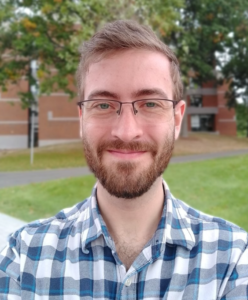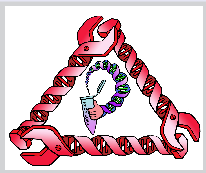Computational Materials Design and Biosensing Using Nucleic Acids
September 20, 2024
Overview
In recent years, DNA-based components have proliferated across a suite of technologically relevant fields, ranging from biomolecular computing, robotics, directed self-assembly, medicine, molecular programming, and biosensing. Such diverse applications stem from the intrinsic programmability of DNA hybridization, allowing for precision control over not only where but how individuals within a multicomponent system interact with each other. The expansive nature of DNA-computed based research, however, also necessitates interdisciplinary training in fundamentals spanning mathematics, physics, biology, and engineering. This means that most researchers looking to dive into the field often do not have comprehensive training of all essential and relevant backgrounds.
This workshop aims to address this pedagogical challenge by providing introductory training for young scientists looking to get started in DNA-based research. Our focus will be to cover fundamental techniques that are entrenched in the field and validated via extensive crosstalk between experiments, modeling, and theory. Specifically, we will provide overviews of state-of-the-art theory, computational, and experimental approaches relevant for DNA-computing research. Attendees will get a chance to learn about open-sourced computational tools designed to model and predict DNA-mediated process as well as common experimental protocols through the lens of biosensors and molecular programming. Emphasis will be placed on providing hands-on tutorials to help familiarize attendees with many of the presented topics.
Session I: Computational Workshop
Nucleic acid-based nanoscale building blocks have grown in popularity over the past decades, especially in the creation of multifunctional composites materials.
This is because DNA/RNA hybridization provides a handle for programming specific, directional interactions at the molecular level, enabling robust control over spatial and orientational orderings that propagate to technologically relevant micron and millimeter scales. A major bottleneck in a priori design of such materials, however, lies in design space complexity. For this reason, computational modeling has become a powerful screening toolkit to rapidly search across the experimentally accessible parameter space.
This workshop will bring together researchers working in both theory and simulation of nucleic acid based materials to present state-of-the-art approaches, providing a platform to mediate the exchange of ideas that can lead to the development newer tools capable of filling critical gaps in fundamental understanding of DNA/RNA building block designs. The workshop will feature a plenary talk on the state of the field followed by hands-on tutorials on tools for theory and computational modeling of DNA/RNA-mediated self-assembly.
Schedule:
8:00 AM – 8:15 AM: Registration/Check-In
8:15 – 9:10 AM: Keynote (45 minutes + 15 minutes Q&A, Gaurav Arya)
Title: Folding and Higher-Order Assembly of DNA Origami

9:15 – 9:30 AM: Introduction of Tutorial Topics
9:30 AM – 9:45 AM: Mapping Experimental Parameters to Computational Potentials and Assembly Prediction
Speaker: Thi Vo, Johns Hopkins University

9:45 AM – 10:00 AM: HOODLT as a General Tool for Simulation of Ligands
Speaker: Alex Travesset, Iowa State University

10:00 AM – 10:15 AM: Lattice Detection and Analysis Using PeakyFinders
Speaker: Timothy C. Moore, University of Michigan – Ann Arbor
10:15 AM – 10:30 AM: Combining cryo-EM and elastic models to understand DNA origami self-assembly
Speaker: Thomas Videbaek, Brandeis University

11:00 AM – 1:20 PM Lunch and Hands-On Tool
Session II: Integrating Molecular Biosensing and Nucleic Acid Computation
Nucleic acid components and circuits, such as aptamers, toehold mediated strand displacement (TMSD) gates, and riboregulators, hold great promise for sensing and classifying complex biomolecular patterns associated with disease, environmental contamination, and cellular processes. However, integrating multiple biosensing modalities together with nucleic acid circuits for classification remains challenging. This workshop will bring together stakeholders in biosensor development and molecular programming to exchange ideas on the development of the next generation of smart biosensing technology.
The workshop will feature a plenary talk on the state of the field, brief tutorials on different biosensing technologies from early career scientists, and a panel discussion on the challenges that need to be addressed to successfully deploy smart biosensors as products. The program is geared towards graduate students and postdocs, but we welcome attendees at all levels who are interested in learning about different biosensing modalities.
Tentative Schedule
1:20 PM – 1:40 PM: Registration/Check-In
1:40 – 2:40 PM: Keynote (30 minutes + 15 minutes Q&A, Andy Ellington)
Title: Directed evolution and computational design of biosensors.
2:40 PM – 3:00 PM: Integrating Molecular Biosensing with RNA Circuits
Speaker: Sam Schaffter, NIST
3:00 PM – 3:20 PM: Biosensing with Nucleic Acid Nanotechnology
Speaker: Rizal Hariadi, Arizona State University
3:20 PM – 3:40 PM: Integrating Small Molecular Biosensing and Nucleic Acid Computation
Speaker: Jenni Li, Northwester University
3:40 PM – 4:00 PM: Electrochemical Biosensors Using Nucleic Acid Aptamers
Speaker: Netzahualcoyotl Arroyo Curras, Johns Hopkins University
4:00 PM – 5:00 PM Panel discussion: Biosensing and Molecular Computation in the Real-World
Panelists
Venkatesh Srinivasan, University of Maryland Baltimore County
Tza-Huei (Jeff) Wang, Johns Hopkins University
Andy Ellington, University of Texas – Austin
5:00 PM – 6:30 PM Reception / Happy hour
Registration has closed.
